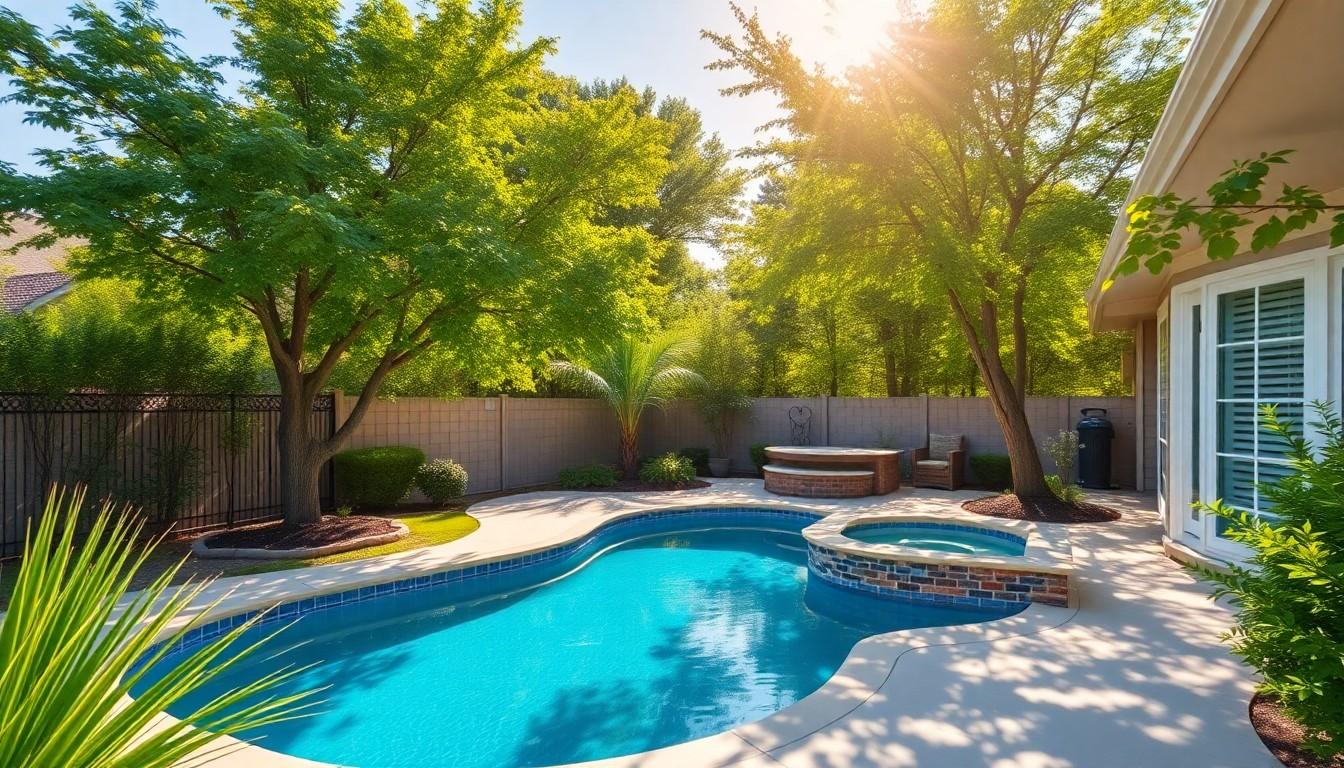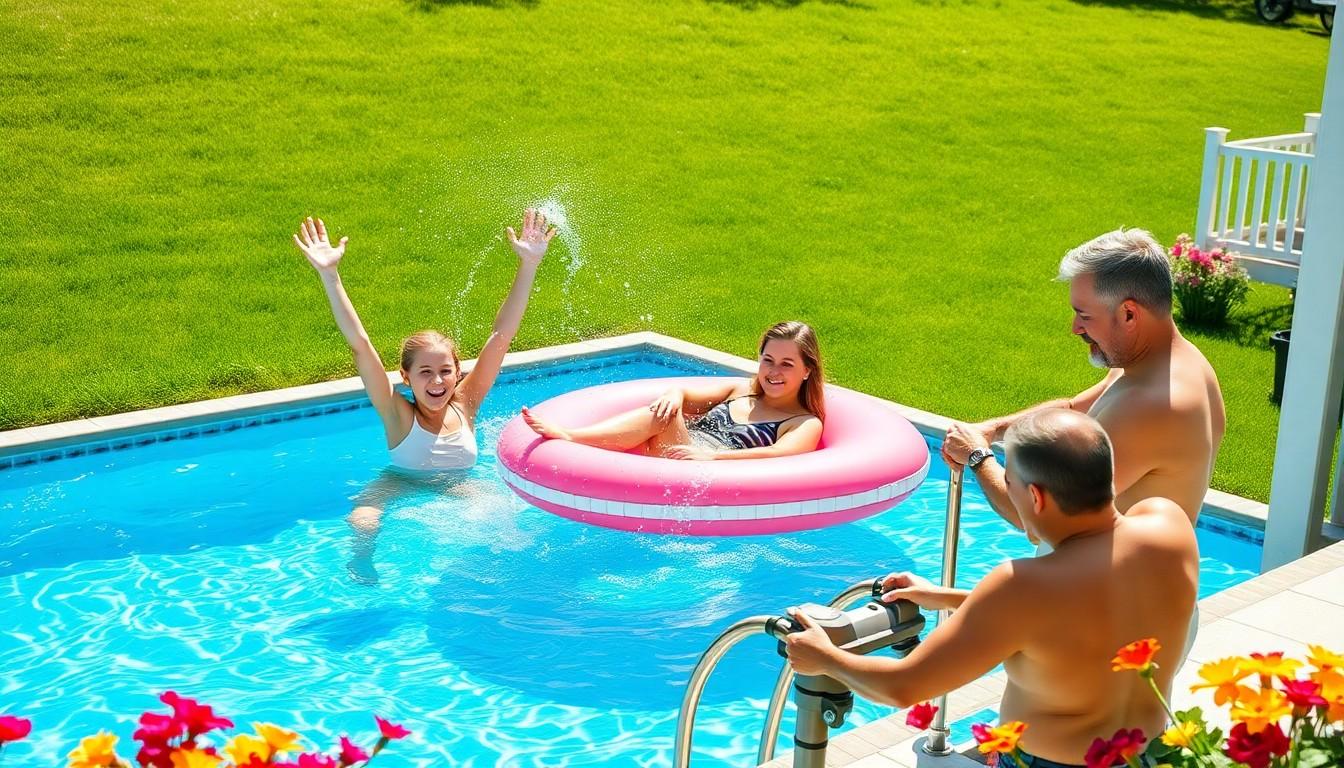Imagine stepping into your backyard and diving into your very own oasis. Building a swimming pool isn’t just about splashing around; it’s about creating a personal paradise that transforms your home into a summer sanctuary. Whether it’s for family fun or hosting epic pool parties, a swimming pool can elevate your lifestyle and add value to your property.
Table of Contents
TogglePlanning Your Pool Project
Creating a swimming pool requires careful planning to ensure it meets your needs and complements your outdoor space. From sizing to budgeting, each decision plays a crucial role in the project’s success.
Determining Pool Size and Shape
Choosing the right size and shape for your pool depends on space, intended use, and aesthetic preference. Standard dimensions range from 10×20 feet to larger sizes over 20×40 feet. Shapes vary from rectangular and oval to freeform designs that blend with landscapes. Space constraints may limit options, so consider surrounding features like trees, decks, and fencing. Additionally, think about how you plan to use the pool, whether for exercise, relaxation, or entertaining. Knowing these details helps in selecting the best fit for your property.
Budgeting for Your Swimming Pool
Budgeting for a swimming pool involves several key aspects, including installation, materials, and ongoing maintenance. The average cost for an in-ground pool can range from $30,000 to over $100,000, depending on location and specific features. Materials such as fiberglass, vinyl, or gunite influence overall price. Don’t forget to account for additional elements like landscaping, fencing, and heating systems, which contribute to initial expenses. Estimating monthly maintenance costs ensures long-term financial planning aligns with expectations. By clearly outlining these expenses, you position yourself to make informed decisions throughout the project.
Choosing the Right Location

Selecting the right location for a swimming pool involves careful consideration of several key factors. Assessing sunlight, shade, accessibility, and safety can significantly impact overall enjoyment and functionality.
Sunlight and Shade Considerations
Sunlight exposure shapes the pool experience. Placing the pool in an area that receives ample sun enhances warmth and promotes comfortable swimming. Shade from nearby trees or structures offers relief during hot days but can also affect water temperature. Evaluating sunlight patterns at different times of the day helps determine the best spot. Homeowners should consider avoiding areas with excessive shade, which could limit sun access and hinder enjoyment. Balancing sun and shade creates an ideal environment for relaxation and recreation.
Accessibility and Safety Factors
Accessibility plays a crucial role in pool location decisions. Proximity to the home streamlines movement, making it easier to supervise children or bring supplies. Ensuring easy access to entrances and exits enhances safety. Consideration of fencing requirements is vital in securing the area and preventing accidental entry. The chosen location should also provide clear pathways to avoid hazards. Prioritizing safe entry and exit points creates a family-friendly environment, allowing everyone to enjoy the pool with peace of mind.
Pool Construction Process
Building a swimming pool involves several key steps that ensure a successful and satisfying outcome. The process begins with excavation, followed by the installation of the pool’s walls and floor.
Excavation and Ground Preparation
Excavation involves digging a hole in the ground based on the pool’s design specifications. Heavy machinery like backhoes or excavators typically handles this task, ensuring the correct dimensions are met. Ground preparation follows excavation and includes leveling the base and addressing drainage issues. Properly grading the area promotes effective water runoff, preventing future flooding concerns. Once completed, the site is ready for the construction of pool walls and flooring.
Installation of Pool Walls and Floor
Installation of pool walls and floor occurs after site preparation. Concrete panels or steel walls are commonly used to form the pool structure, depending on the chosen design. Concrete is poured or set, creating a sturdy floor that provides support. The installation includes reinforcing the walls with steel rebar for added stability. Workers also consider plumbing and electrical configuration during this phase to ensure functionality once the pool is operational. This stage establishes a solid foundation for the entire pool system.
Finishing Touches
Finishing touches elevate the aesthetics and functionality of a swimming pool. Attention to detail ensures a stunning and durable result.
Selecting the Pool Liner
Choosing a pool liner affects both appearance and maintenance. Options include vinyl and fiberglass, each with distinct benefits. Vinyl liners come in various colors and patterns, offering personalization. Durability features play a role in decision-making since thicker liners often last longer. Fiberglass, although more limited in designs, requires less upkeep and can be easier to clean. Both materials should meet safety and environmental standards to ensure longevity and safety.
Adding Tiles and Coping
Tiles and coping add a polished look to the pool’s edge. Various materials exist, including ceramic, glass, and natural stone, which can enhance aesthetic appeal. Durability differs across materials, with some resisting slipping better than others. Coping serves essential functions, providing smooth transitions from the deck to the water while preventing algae growth. Installation techniques matter greatly; professionals often recommend mortar setting for stability. The right combination results in a beautiful, functional pool border that complements the overall design.
Pool Maintenance Tips
Maintaining a swimming pool requires consistent effort to ensure cleanliness and safety. Proper maintenance enhances the longevity of the pool and provides a pleasant swimming experience.
Regular Cleaning and Chemical Balance
Cleaning the pool regularly is essential for preventing algae growth and debris accumulation. Skimming the surface with a net removes leaves and contaminants. Vacuuming the pool floor helps eliminate dirt and sediment. Testing water chemistry two to three times a week ensures the correct pH levels, usually between 7.2 and 7.8. Additionally, maintaining proper chlorine levels between 1 and 3 parts per million keeps the water sanitized. Balancing alkalinity acts as a buffer for pH, thereby reducing fluctuations. These practices together create a safe and enjoyable swimming environment for everyone.
Winterization Techniques
Winterizing the pool prepares it for cold months, preventing damage from freezing temperatures. First, clean the pool thoroughly, removing all debris. After that, lower the water level to below the skimmer, preventing ice expansion damage. Adding winterizing chemicals protects the water during inactivity. Covering the pool with a durable winter cover keeps debris out and protects it from harsh weather. Lastly, removing and storing accessories like ladders and floats extends their lifespan. Following these winterization steps ensures a trouble-free opening when warmer weather returns.
Conclusion
Building a swimming pool is a significant investment that offers numerous benefits. It transforms a backyard into a personal retreat while enhancing family time and social gatherings. With careful planning and attention to detail homeowners can create a stunning pool that complements their lifestyle and increases property value.
By prioritizing factors like location size and materials homeowners can ensure their pool meets both aesthetic and functional needs. Additionally regular maintenance is essential for keeping the pool safe and enjoyable for years to come. Embracing these considerations can lead to a rewarding experience that brings joy and relaxation to the entire family.

